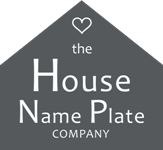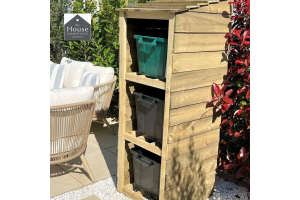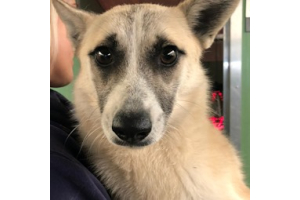
What are the Rules surrounding Gravestones in a Cemetery?
The rules surrounding gravestones vary depending on the cemetery. Whether it's privately owned or council owned, the cemetery will have its own set of regulations you need to abide by. It is important to check these out, as they can stipulate the style, wording, size and material used.
Types of Gravestones:
For the first six weeks to twelve months (depending on the burial site), you will be advised to not fit a gravestone. The earth needs time to settle so a gravestone fitted too early may sink. This can be distressing, as it is understandable that you want a nice place to visit your loved one. Some cemetaries will allow you to place a temporary memorial, such as a wooden cross or plaque. The House Nameplate Company sell a lovely range of slate gravestones on a plinth or a stake that can be placed at your memorial site while you wait for the ground to settle.
Once you are allowed to fit a permament gravestone you need to check what types of gravestones your cemetary allows. There are plenty to choose from:
Upright Gravestone:
Upright gravestones are the most common. In most circumstances they are tall, thick and rounded with a concrete base. Upright gravestones are made from a wide selection of materials, most commonly granite and marble. They ususally have an inbuilt vase in the base of the gravestone. Normally they are three feet high by two and a half feet wide by one foot deep.
Flat Tablet:
These simple gravestones which tend to be rectangular, are either flush with the ground or raised very slightly to allow water run off. They are usually cheaper than other gravestones but don't contain as much information as other gravestones. Flat or ground level gravestones are usually made from either granite or bronze.
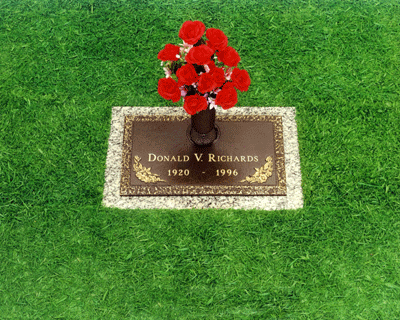
Flat Headstone
Desk Tablet:
Also known as as the DVT (Desk vase tablet) gravestone. They resemble a book with inbuilt vases at the top. It is recommended to have a cement foundation to keep them in place.
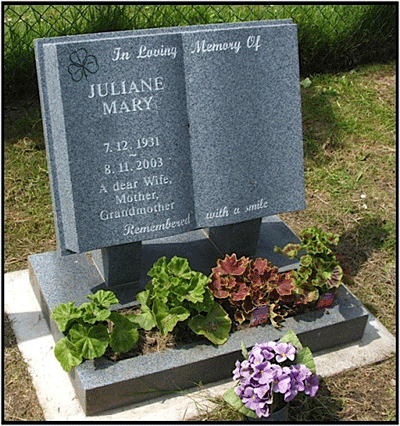
Desk tablet
Ledger Slab:
Ledger slabs are thick slabs of granite, marble or sandstone which cover an entire grave. They are often used in conjunction with other gravestones or memorial plots. Ledger slabs can also be joined together to create a multiple burial plot. They require less maintenance than grass and are easy to wipe down.
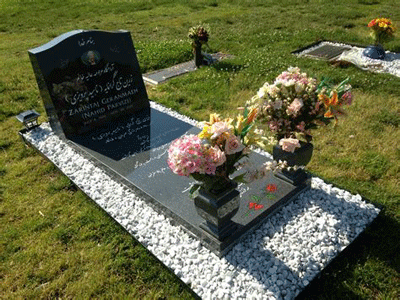
Ledger Slab
Obelisk:
These tall columns are mounted on pedestals and point up towards the sky. They vary in height and they can be as plain or as intricate as you prefer.
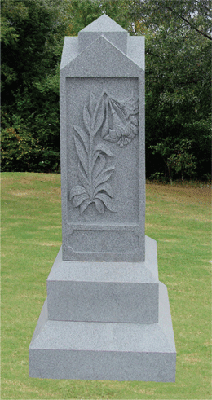
Obelisk
Lawn memorials:
A lawn memorial is made to be fixed at the head of a burial plot with a classic base and headstone combination. They can be crafted using a large range of materials – all with lasting durability and protection against weathering. Other types of memorial, often for use in a private garden, include benches, statues, ornaments and water features. It is very important to check the rules and regulations surrounding such features though as not all cemeteries will allow these features.
Kerb memorials:
These memorials include a line of stone which form a rectangular edge covering the whole grave. Kerb memorials create a set area and allow your loved one’s memorial to stand out in a cemetery. They can have different types of cover slabs or chippings, or alternatively they can be left open for planting.
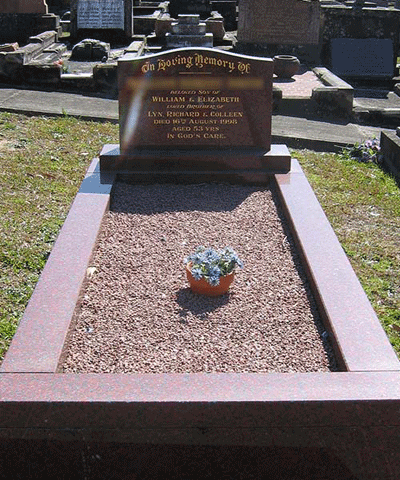
Kerbed Memorial
Bespoke memorials:
A bespoke memorial means that you can personalise it to make it unique, and tell a story. An alternative design can really reflect the individual personality of your loved one for family and friends to recognise. You can choose exactly what size, shape, colour and finish you would like your memorial to have. It is important though to check the cemeteries rules and regulations as not all allow such individuality.
Cremation memorials:
Cremation memorials range from headstones to plaques, to urns and vases. These kind of memorials can give you a point of focus to connect with your loved one.
Children’s gravestones and memorials:
Choosing a memorial to remember a child can be extremely painful. You may feel that you need to make the decision gently, and in your own time. Gravestones for children and teenagers are often inspired by their youth. Many infant gravestones are shaped like teddy bears, favourite toys, angels, hearts, etc. Teenage gravestones can have carvings that represent their hobbies, such as music notes or cars. Always check the rules and regulations of the cemetery if you plan on purchasing something out of the ordinary.
Gravestone Materials to choose from:
Material plays an important part in the durability of the gravestone. Granite, bronze and marble are the most commonly used materials but there are other options.
Granite is a material which boasts great durability and can withstand virtually any weathering. It’s available in a variety of colours, such as black, red, blue and grey. Granite was traditionally very expensive but is now far more affordable.
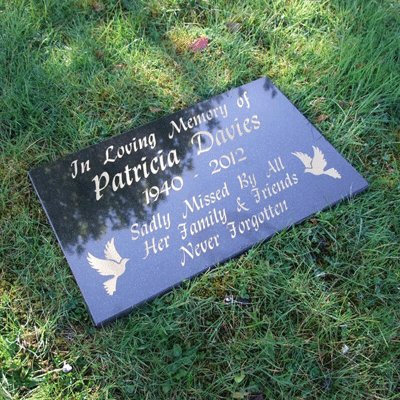
Granite
Bronze is also popular due to its hardy nature. However, bronze will often darken over time, but is resilient and easy to maintain. It is generally more expensive than granite.
Marble is strong and looks great but it’s not as durable as granite and is more susceptible to weathering. It can’t be placed placed in damp areas due to its weakness in structure. This means that inscriptions will likely fade over time.
Limestone is another common gravestone material. Nabresina is the most commonly used form of limestone and is a light beige colour. It’s durable and suitable for most churchyards. Nabresina can make an ideal alternative to white marble and is just as pleasing to the eye. Portland Stone is another widely used form of limestone.
Slate is hard wearing, weatherproof and has a unique grain. It is easy to engrave and comes in natural shades of black, charcoal, grey and green.
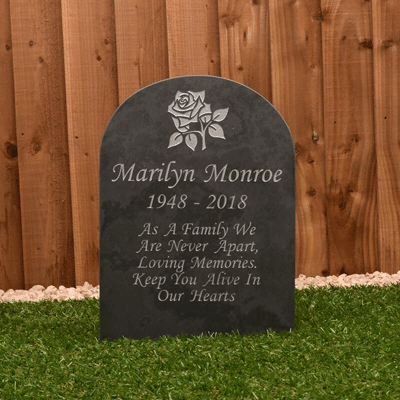
Before you make a choice of material, make sure it is allowed as some cemetaries stipulate what to use to create a uniform look.
What wording to choose?
When it comes to wording for a gravestone, you need to consider font as well as inscription. Different fonts can add character to a gravestone. The most popular option is a Roman font or one very similar. Highly stylised fonts such as elaborate ‘script’ like fonts may look good on paper but are often very unsuitable when cutting into stone. More simple italic style fonts are often used for verses, bible passages, poetry and quotes. It is also important to choose a font of contrasting colour to the gravestone to ensure the wording stands out.
The inscription is one of the most important parts of a gravestone. It’s the message that will represent the life of your loved one and should be timeless and dignified. It can contain anything from bible passages to quotes to poems, and should summarise the dead person’s life, beliefs and accomplishments. This can be very difficult since it’s hard to summarise somebody in just a few words. Common phrases include 'Rest in Peace', 'In loving memory of…', 'Forever in our thoughts', etc. Any personal phrases need to be checked to make sure they comply with the rules and regulations belonging to your particular cemetary.
